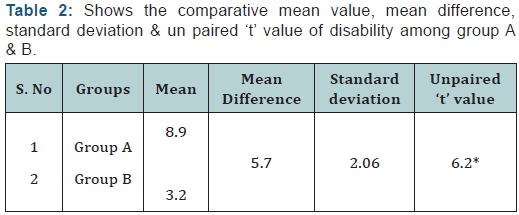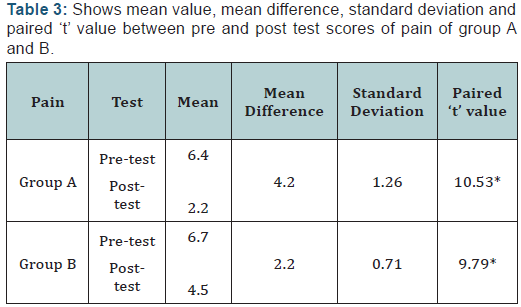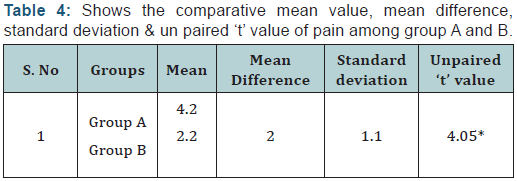Comparative study on Effectiveness of Lumbar Stabilization Exercises and Progressive Strengthening Exercises in the management of Pain and Disability among Lumbar Micro Discectomy Patients
MK Franklin Shaju*1, S Mahalakshmi2 and S Gerald Edwin Raj2
1Professor in Physiotherapy, RVS College of Physiotherapy, India
2Assistant Professor in Physiotherapy, RVS College of Physiotherapy, India
Submission: November 07, 2016; Published: November 18, 2016
*Corresponding author: MK Franklin Shaju, Professor in Physiotherapy, RVS College of Physiotherapy, Sulur, Coimbatore, India, Tel:09843671222 ; Email:franklin25in@gmail.com
How to cite this article: MK F S, S Mahalakshmi, S Gerald E R. Comparative study on Effectiveness of Lumbar Stabilization Exercises and Progressive Strengthening Exercises in the management of Pain and Disability among Lumbar Micro Discectomy Patients. Ortho & Rheum Open Access J. 2016; 3(4): 555617. DOI: 10.19080/OROAJ.2016.03.555617
Abstract
Background: In industrialized countries, approximately 80 % of the adults are getting low back pain at some time at their lives. There are many causes for low back ache, still most important one is disc herniation and there is range of approaches to treat this disc herniation from conservative treatment to spinal surgery. Exercise programs following surgery are most important to restore the functions. The aim of the study was to compare the effects of lumbar stabilization exercises and progressive strengthening exercise in patients with lumbar microdisectomy.
Methodology: Twenty post lumbar micro discectomy subjects were selected for the study and divided into two groups, one group received lumbar stabilization exercises and another group received progressive strengthening exercises. Exercises were given two sessions per day and the same was continued for 14 days. Before starting the exercises disability and intensity of pain were measured by rolandmorris questionnaire and visual analogue scale respectively. The measurements were repeated after two weeks.
Results: The data’s were analyzed statistically by paired‘t’ test and unpaired‘t’ test. The results concluded that both lumbar stabilization exercises and progressive strengthening exercises were effective in reducing disability and pain among post lumbar micro discectomy patients. But when comparing both it was found that lumbar stabilization exercises are more effective than progressive strengthening exercises in reducing disability and pain among post lumbar micro discectomy subjects.
Keywords: Micro discectomy; Lumbar Stabilization Exercise; Progressive Strengthening Exercise; Pain and Disabil
Introduction
Low back pain is one of the most common causes of physical therapist visits in almost all countries with socioeconomic burden. Because of this burden, numerous studies have focused on its management. Disc herniation at lumbar spine level is one of the common cause for low back pain. Herniated lumbar disc is a displacement of disc material such as nucleus pulpous or annulus fibrosis beyond the intervertebral disc space [1]. Studies show that the incidence of lumbar disc herniation (LDH) increases with age. The most common site of LDH is toward the bottom of the spine at L4-L5 or L5-S1. The highest prevalence is among people aged 30-50 years, with a male to female ratio of 2:1. In people aged 30-50 years, about 95% of herniated discs occur at the lower lumbar spine of L4/5 and L5/S1 level [2]. There are many causes for Lumbar disc herniation. One of the main reasons is aging. Normally discs have high water content.
As getting older discs begin to dry out and weaken, the disc begins to shrink and spaces between the vertebrae get narrower.
This results in disc herniation. Men between the ages of 30 and 50 are most likely to have a herniated disk. Improper lifting, twisting while lifting, obese individual and frequent driving are few other causes for disc herniation. A microdiscectomy surgery is used to treat a herniated intervertebral disc. It is most commonly performed on the lumbar (lower) region of the spine. During this procedure, a portion of bone or disc material is removed in order to provide relief to an impinged nerve root in the spinal column [3]. Exercise therapy is an important part of rehabilitation after lumbar micro discectomy. Different types of exercise protocols are proved as effective in rehabilitating post lumbar micro discectomy patients. Two of such exercise protocols are lumbar stabilization exercises and progressive spinal extensor muscles strengthening exercises [4,5].
Materials and Methods
It was a pre and posttest experimental study. One month duration of post surgery lumbar microdisccectomy men patients with the age of 30-40 years were selected for the study by simple random sampling method. Out of them ten were allotted in group A for lumbar stabilization exercise and ten were allotted in group B for progressive strengthening exercises, medical conditions which limits exercise tolerance and cardiac patients were excluded from the study. All the subjects who satisfied the inclusion and exclusion criteria were included for the study after taking acceptance through the written consent form. Both lumbar stabilization exercises and progressive strengthening exercises were given for a period of two weeks, daily two sessions. Patient’s disability and pain were measured by rolandmorris questionnaires and visual analogue scale respectively. Study variables were measured at zero weeks and at the end of second week of the study for analyses.
Lumbar Stabilization exercises (Stabilization with Progressive Limb Loading-Emphasized on Trunk Extensors)
The subjects were advised to be relax before training and following warm up, the subjects were asked to perform the following exercises in the quadruped position.
- Lifting one upper extremity and then the alternate upper extremity.
- Lifting one lower extremity with leg slide and then the alternate lower extremity.
- Lifting one lower extremity by lifting it off the ground and then the alternate lower extremity.
- Lifting one upper extremity while lifting contra lateral lower extremity and then the alternate extremities.
- Then the subjects were asked to perform the following exercises in the prone position.
- Extending one lower extremity and then the alternate lower extremity.
- Extending both lower extremities.
- Lifting head, arms and trunk.
All the subjects were asked to maintain each position for 10 seconds and then return to the starting position.10 repetitions of each exercises were done in one session, two sessions per day and the same was continued for two weeks.
Progressive Strengthening Exercises (Extension Exercises in Prone Position)
Thoracic elevation: The subjects were made to lie in prone position and both the arms at the side. Subjects were asked to tuck in the chin lift the head and thorax. The lower extremities were stabilized by the therapist. Based on patients ability thoracic elevation exercise was progressed by keeping the arms behind the head or reaching overhead.
Leg lifts: The subjects were made to lie in prone position and asked to lift lower extremities one by one, then both legs and down. Based on patients ability leg lift exercises were combined with spine extension progressively. Subjects were asked to stabilize the thorax by holding the sides of the treatment table. All the subjects were asked to repeat thoracic elevation and leg lift exercises for 10 times. 10 repetitions of each exercise were done in one session, two sessions per day and the same was continued for two weeks.
Roland Morris Questionnaires: It consists of twenty selfrated questions. The patients were instructed to put a mark next to each appropriate statement. The total numbers of marked statements are added. That’s the disability score of each individual.
Visual Analogue Scale: Visual analogue scale was used to measure the severity of pain. It consists of a 10cm line with two end-points representing “no pain” and “worst pain”. Patients were asked to rate their pain by placing a mark on the scale corresponding to their current level of pain.
Results




(Tables 1-4) In Group A, the calculated paired‘t’ value for disability and pain are 11.63 and 10.53 respectively at 0.05 level significance and the ‘t’ table value is 2.262, Hence the calculated ‘t’ values are more than ‘t’ table value, the study shows that there is significant difference in disability and pain following lumbar stabilization exercises among lumbar microdiscectomy patients. In Group B, the calculated paired ‘t’ value for disability and pain are 10.8 and 9.79 respectively at 0.05 level significance and the ‘t’ table value is 2.262, Hence the calculated ‘t’ values are more than ‘t’ table value, the above study shows that there is significant difference in disability and pain following progressive strengthening exercises among lumbar microdiscectomy patients.
When analyzing the values of Group A and Group B by unpaired ‘t’ test, the calculated t’ value for disability and pain are 6.2 and 4.05 respectively at 0.05 level significance and the table ‘t’ value is 2.101, Hence the calculated ‘t’ value is more than ‘t’ table value, the above study shows that, there is significant difference between lumbar stabilization exercises and progressive strengthening exercises in reducing disability and pain among lumbar microdiscectomy patients. The mean difference value analysis of both the groups shows that there is more difference in disability and pain following lumbar stabilization exercises than progressive strengthening exercises in lumbar microdiscectomy patients.
Discussion
Around one fourth of the patients who have been operated for lumbar disc herniation have post-operative complaints. It is also known that in operated and non-operated patients there is lumbar, abdominal and dorsal muscle weakness [6]. Kahanowitz et al. [7] have reported that the trunk muscles’ strength is decreased about 30% after discectomy operation. Hence, both operated and non-operated low back patients need to follow an exercise programme for the relief of their painful backs. In the present study both lumbar stabilization exercises and progressive strengthening exercises showed significance in reducing disability and pain among lumbar microdiscectomy patients. The results were supported by Manniche et al. [8], they did a study on 96 lumbar microdiscectomy patients and concluded that lumbar stabilization exercises are more effective than more general and moderate level of exercise programme.
Also Choi et al. [9], did a study with 80 individuals with chronic low back pain after lumbar discectomy surgery.Subjects were randomly assigned to lumbar extensor strengthening exercise and home exercise groups. The lumbar extensor strengthening group performed isolated progressive resisted lumbar extensor strengthening exercises. Both the group showed significant reduction in disability and pain after 12 weeks but results of cross-sectional areas showed that lumbar extensor strengthening exercise were significantly greater than home exercises.
Conclusion
The study aims at explore the effectiveness of lumbar stabilization exercises and progressive strengthening exercises on disability and pain among lumbar microdiscectomy patients. Twenty post lumbar microdiscectomy patients of one month duration, fulfilled inclusion and exclusion criteria were selected for the study and randomly divided in to two groups A and B. Group A received lumbar stabilization exercises and group B received progressive strengthening exercises for a period of two weeks. Before starting the treatment disability and pain were measured by rolandmorris questionnaires and visual analogue scale respectively. The measurements were repeated after two weeks.
The data’s were analyzed statistically by paired ‘t’ test and unpaired ‘t’ test. The results showed that both lumbar stabilization exercises and progressive strengthening exercises were effective in reducing disability and pain among lumbar microdiscectomy patients, but when comparing both lumbar stabilization exercises group showed more reduction in disability and pain among lumbar microdiccectomy subjects than progressive strengthening exercises group.
References
- Jo Jordon, KikaKonstantinou, John O’Dowd (2009) Herniated lumbar disc. BMJ clinical evidence.
- Ma D, Liang Y, Wang D, Liu Z, Zhang W, et al. (2013) Trend of the incidence of lumbar disc herniation: decreasing with aging in the elderly. Clin Interv Aging 8: 1047-1050.
- Yash Gulati (2004) Lumbar Microdiscetomy. Apollo Medicine Vol 1.
- Kulig K, Beneck GJ, Selkowitz DM, Popovich JM Jr, Ge TT, et al. (2009) An intensive, progressive exercise program reduces disability and improves functional performance in patients after single-level lumbar microdiskectomy. Phys Ther 89(11): 1145-1157.
- Hebert JJ, Marcus RL, Koppenhaver SL, Fritz JM (2010) Postoperative Rehabilitation Following Lumbar Discectomy With Quantification of Trunk Muscle Morphology and Function: A Case Report and Review of the Literature. J Orthop Sports Phys Ther 40(7): 402-412.
- Sinaki M, Mokri B (1996) Low back pain and disorders of the lumbar spine. In: Braddom RL, Buschbacher RM, Dumitru D, Johnson EW, Matthews D, et al. (eds), Physical medicine & rehabilitation. WB Saunders Co, USA, 39: 813-850.
- Kahanowitz N, Viola K, Gallagher M (1989) Long-term strength assessment of postoperative discectomy patients. Spine 14: 402-403.
- Manniche C, Skall HF, Braendholt L, Christensen BH, Christophersen L, et al. (1993) Clinical trial of postoperative dynamic back exercises after first lumbar discectomy. Spine 18(1): 92-97.
- Choi G, Raiturker P, Kim M, Chung D, Chae Y, et al. (2005) The effect of early isolated lumbar extension exercise program for patients with herniated disc undergoing lumbar discectomy. Neurosurgery 57(4): 764-772.






























